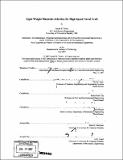Light-weight materials selection for high-speed naval craft
Author(s)
Torrez, Joseph B. (Joseph Benjamin)
DownloadFull printable version (7.865Mb)
Other Contributors
Massachusetts Institute of Technology. Dept. of Civil and Environmental Engineering.
Advisor
Thomas Eagar.
Terms of use
Metadata
Show full item recordAbstract
A decision analysis study was conducted on the process of materials selection for high-speed naval craft using the Modified Digital Logic (MDL) method proposed by B. Dehgham-Manshadi et al in ref [17]. The purpose is to show how this method along with Ashby's material selection process can be integrated to provide a comprehensive tool designed specifically for light-weight material optimization. Using Ashby's Material Selection Charts and the MDL method, a step by step material selection process is outlined. Furthermore, a comparison of the materials based on equivalent plate uni-axial ideal elastic compressive stress was completed using the American Bureau of Shipbuilding (ABS) Guide for Building and Classing High-Speed Naval Craft and then an evaluation was done to optimize material selection depending on the designer's preference for weight and cost. The potential materials for evaluation were selected using Naval Sea Systems Command (NAVSEA) references for the most current materials in use, or being evaluated, for light weight naval construction. The results demonstrate the feasibility of using the MDL method to select one or more materials based on desired mechanical and structural characteristics. The study also introduces the potential use of non-traditional materials in Naval Architecture, such as Ultra High-Performance Concrete Composite (UHP2C) DUCTAL ©.
Description
Thesis (Nav. E.)--Massachusetts Institute of Technology, Dept. of Mechanical Engineering; and, (S.M.)--Massachusetts Institute of Technology, Dept. of Civil and Environmental Engineering, 2007. Includes bibliographical references (p. 109-111).
Date issued
2007Department
Massachusetts Institute of Technology. Department of Civil and Environmental Engineering; Massachusetts Institute of Technology. Department of Mechanical EngineeringPublisher
Massachusetts Institute of Technology
Keywords
Mechanical Engineering., Civil and Environmental Engineering.